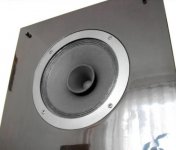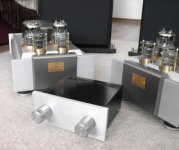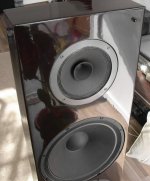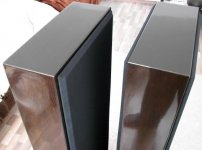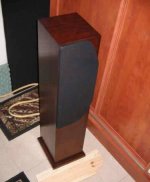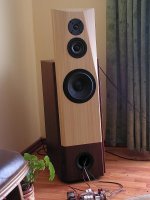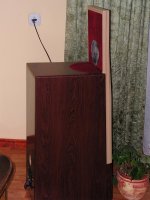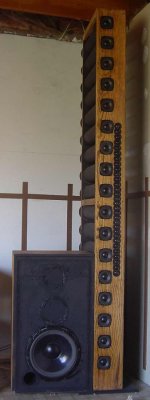SimontY said:That looks like a fantastic setup! I will try open baffles one day.
I waited for it for far too long! Don't miss out on it, it's worth it IMO
Looks good Felixx, must be quite an efficient pair!
Re: My open baffles
Do those monoliths really sound as stunning as they look??? Congratulations.
Ricky.
felixx said:My open baffle with Supravox 215RTF Bicone and Alpha 15A from Eminence.
Sublime sound.
Stunning.
Do those monoliths really sound as stunning as they look??? Congratulations.
Ricky.

Banned
Joined 2002
Here is what i have been working on for the last week,
An externally hosted image should be here but it was not working when we last tested it.
An externally hosted image should be here but it was not working when we last tested it.
Pictures:
http://pub48.bravenet.com/photocenter/album.php?usernum=4095425731&album=48032
The Calipso Array has been developed on a model that includes the following essential characteristics:
Two 12 inch 15mm Xmax Goldsound Polyprop, foam surround Woofers
34 Sammi, 3 inch mid woofers: 3.3mm X-max, Copper coils, composite paper/fab cone, foam surround
60 Dayton ND20FA 3/4 inch silk dome tweeters with flanges cut to a .9 inch Center-to-center distance
Rane Ac-23 Analog Electronic Crossovers, at 165hz & 2600hz
Tri-amplification: 60 w/ch for tweeter array, 150 w/ch mid/woofer array, 350 w/ch woofers
1. Three-Way design.
In point source speaker systems, a two way design is often considered to be an inadequate compromise. Much of audio has gone to two way designs with a single sub woofer. Vance Dickason in his 6th Edition of The Loudspeaker Cookbook has indicated that the use of dual woofers that are capable of subwoofer frequencies produces a significantly better sound image than a subwoofer. In this design a large 12 inch, high mm Xmax woofer is used with each side, and it crosses to the mid ranges at about 165hz. While mine are not currently in the correct size box, the correct size is a 6-8 cu ft vented box.
2. No Crossover in the 2 most sensitive areas of human hearing: 300hz – 3000hz, where all the critical timbre of instruments abodes, and 3000 – 6000hz where human hearing can perceive the most differences between sounds. Obviously this is impossible, so a compromise to be at the edge of both ranges was chosen for the upper crossover.
Rod Elliot at Southwest Audio( http://sound.westhost.com/bi-amp2.htm ) makes the case better than I:
“It is not at all uncommon to see systems where the crossover frequency is set right in the middle of what I call the "intelligence band". This is the range of frequencies from 300Hz to 3000Hz, and is extremely important from a psycho-acoustic point of view.
“It is no accident that this is the range of the telephone system (and has been for many years). If we are only to hear a limited range, then this band of frequencies is by far the most important. Just from this we can recognize a person's voice, which musical instrument is being played (even bass instruments!), and - more importantly - what is being said. It contains nearly all the "intelligence" of the sound, which is to say that if this band is "corrupted", intelligibility is greatly reduced.
“So why do speaker manufacturers insist on placing their crossover frequencies within this band of frequencies? The public address (PA) systems used by many rock bands are a case in point - how often does one find that the vocals are completely unintelligible? Mind you, it may also be the case that the band's lyrics just don't make sense, but that's another story altogether.
“Often this occurs because the system is so loud that the amplifiers are clipping badly, but even at lower levels it is quite common. Place a common-or-garden crossover filter right in the middle of the "intelligence band" and this is exactly what will (and does) happen. With phase aberrations and cancellations, this most important frequency range becomes muddied and indistinct causing loss of intelligibility - not only on voice, but instruments as well.
“The effect is also noticeable with some hi-fi speaker systems, except that it usually less pronounced, and it is far less likely that the amplifier will be driven to clipping. Reviewers will often say of a speaker that the vocals seem veiled, or that there is noticeable coloration of either male or female vocals. These effects are often caused by the effects of phase shift around the crossover frequency, coupled with the fact that the crossover frequency falls right in the middle of the intelligence band.”
This very hard to do with point source speakers, but with line arrays, the midrange speakers are often loafing along, and if they have the range, pulling the wagon as a group of horses, they can do the job admirably.
3. Use Electrical Crossovers.
Again, passive crossovers are, IMO, a DATED TECHNOLOGY. Passive’s introduce so much negative into the sound that they should not be there. And the cost of a top of the line passive cross(with the increased cost of copper) and a electronic is almost the same. Read Rod Elliot’s papers on Bi-Amplification and electronic crossovers at http://sound.westhost.com
The only reason for not using them is that you’ve spent years learning how to design them and you aren’t giving that up, or you are in the business of selling speakers and you aren’t willing to sell amps and crossovers too.
4. Separate the midrange speakers from all other influences.
Bad coloration of sound, in my opinion, is caused by other sound that the direct radiation coming through the speakers. This means that you have to eliminate ANYTHING that goes out the back of the speaker, and anything that might be in the box behind the speaker from coming forward through the speaker again and muddying the sound clarity. (Some people don’t believe that this is impactive.)
To do this, this design uses SEALED separate 4 inch PVC tubes for each of the 34 midrange/mid bass speakers. Each tube is physically separates from its peers by _ inch of open air space.
On page 35 of the Dickason 6th Edition Loudspeaker Cookbook, there is an empirical study on the efficiency of various stuffing materials. The greatest attenuation was determined to be at the 4 lb/cu ft density level. Frequencies within the range of the mid/midbass speaker are right within the range of attenuation. Only by using tubes can the appropriate density be achieved, since the insulation can be stuff tightly against the walls of the tube and not push up against the speaker itself. The part closest to the speaker is protected by a layer of sheet pillowfill from the fiberglass threads that might otherwise get into the voice coil.
A recent study by Rod Elliot showed that the smaller the diameter of the fiber the more effective the attenuation. Pillow fill= .01 in, regular fiberglass=.005 in, Acoustical fiberglass= .001 inch.
Additionally there are some benefits of the tube’s inability to make even ordered harmonics, or even ordered harmonic distortion, but that will not be addressed here.
This design is labor intense but it helps make the 3 inch midrange speaker process viable.
5. Keep the cost down below $1400 (US$) for the speakers, and the required electronics.
6. Keep Comb distortion in the mid and high frequency drivers below Griffin minimums, and use dome tweeter SOUND rather than ribbons or planars, for their flatter frequency response.
The only dome tweeters that I know which have a center to center distance small enough, and at the same time can be crossed low enough, are Dayton Neo ND20FA’s. These have their flanges cut so that the c-to-c is .9 inch, and the comb filter distortion doesn’t start until more than half way into the last octave, or more than 15,000Khz.
All statements except for referred to studies or references are MY OPINION. Stating that they are my opinion is an attempt to avoid an argument since I’m not interested in changing my opinion without substantial data to an opposing point of view. Additionally, the design based on my opinions has worked out spectacularly!
http://pub48.bravenet.com/photocenter/album.php?usernum=4095425731&album=48032
The Calipso Array has been developed on a model that includes the following essential characteristics:
Two 12 inch 15mm Xmax Goldsound Polyprop, foam surround Woofers
34 Sammi, 3 inch mid woofers: 3.3mm X-max, Copper coils, composite paper/fab cone, foam surround
60 Dayton ND20FA 3/4 inch silk dome tweeters with flanges cut to a .9 inch Center-to-center distance
Rane Ac-23 Analog Electronic Crossovers, at 165hz & 2600hz
Tri-amplification: 60 w/ch for tweeter array, 150 w/ch mid/woofer array, 350 w/ch woofers
1. Three-Way design.
In point source speaker systems, a two way design is often considered to be an inadequate compromise. Much of audio has gone to two way designs with a single sub woofer. Vance Dickason in his 6th Edition of The Loudspeaker Cookbook has indicated that the use of dual woofers that are capable of subwoofer frequencies produces a significantly better sound image than a subwoofer. In this design a large 12 inch, high mm Xmax woofer is used with each side, and it crosses to the mid ranges at about 165hz. While mine are not currently in the correct size box, the correct size is a 6-8 cu ft vented box.
2. No Crossover in the 2 most sensitive areas of human hearing: 300hz – 3000hz, where all the critical timbre of instruments abodes, and 3000 – 6000hz where human hearing can perceive the most differences between sounds. Obviously this is impossible, so a compromise to be at the edge of both ranges was chosen for the upper crossover.
Rod Elliot at Southwest Audio( http://sound.westhost.com/bi-amp2.htm ) makes the case better than I:
“It is not at all uncommon to see systems where the crossover frequency is set right in the middle of what I call the "intelligence band". This is the range of frequencies from 300Hz to 3000Hz, and is extremely important from a psycho-acoustic point of view.
“It is no accident that this is the range of the telephone system (and has been for many years). If we are only to hear a limited range, then this band of frequencies is by far the most important. Just from this we can recognize a person's voice, which musical instrument is being played (even bass instruments!), and - more importantly - what is being said. It contains nearly all the "intelligence" of the sound, which is to say that if this band is "corrupted", intelligibility is greatly reduced.
“So why do speaker manufacturers insist on placing their crossover frequencies within this band of frequencies? The public address (PA) systems used by many rock bands are a case in point - how often does one find that the vocals are completely unintelligible? Mind you, it may also be the case that the band's lyrics just don't make sense, but that's another story altogether.
“Often this occurs because the system is so loud that the amplifiers are clipping badly, but even at lower levels it is quite common. Place a common-or-garden crossover filter right in the middle of the "intelligence band" and this is exactly what will (and does) happen. With phase aberrations and cancellations, this most important frequency range becomes muddied and indistinct causing loss of intelligibility - not only on voice, but instruments as well.
“The effect is also noticeable with some hi-fi speaker systems, except that it usually less pronounced, and it is far less likely that the amplifier will be driven to clipping. Reviewers will often say of a speaker that the vocals seem veiled, or that there is noticeable coloration of either male or female vocals. These effects are often caused by the effects of phase shift around the crossover frequency, coupled with the fact that the crossover frequency falls right in the middle of the intelligence band.”
This very hard to do with point source speakers, but with line arrays, the midrange speakers are often loafing along, and if they have the range, pulling the wagon as a group of horses, they can do the job admirably.
3. Use Electrical Crossovers.
Again, passive crossovers are, IMO, a DATED TECHNOLOGY. Passive’s introduce so much negative into the sound that they should not be there. And the cost of a top of the line passive cross(with the increased cost of copper) and a electronic is almost the same. Read Rod Elliot’s papers on Bi-Amplification and electronic crossovers at http://sound.westhost.com
The only reason for not using them is that you’ve spent years learning how to design them and you aren’t giving that up, or you are in the business of selling speakers and you aren’t willing to sell amps and crossovers too.
4. Separate the midrange speakers from all other influences.
Bad coloration of sound, in my opinion, is caused by other sound that the direct radiation coming through the speakers. This means that you have to eliminate ANYTHING that goes out the back of the speaker, and anything that might be in the box behind the speaker from coming forward through the speaker again and muddying the sound clarity. (Some people don’t believe that this is impactive.)
To do this, this design uses SEALED separate 4 inch PVC tubes for each of the 34 midrange/mid bass speakers. Each tube is physically separates from its peers by _ inch of open air space.
On page 35 of the Dickason 6th Edition Loudspeaker Cookbook, there is an empirical study on the efficiency of various stuffing materials. The greatest attenuation was determined to be at the 4 lb/cu ft density level. Frequencies within the range of the mid/midbass speaker are right within the range of attenuation. Only by using tubes can the appropriate density be achieved, since the insulation can be stuff tightly against the walls of the tube and not push up against the speaker itself. The part closest to the speaker is protected by a layer of sheet pillowfill from the fiberglass threads that might otherwise get into the voice coil.
A recent study by Rod Elliot showed that the smaller the diameter of the fiber the more effective the attenuation. Pillow fill= .01 in, regular fiberglass=.005 in, Acoustical fiberglass= .001 inch.
Additionally there are some benefits of the tube’s inability to make even ordered harmonics, or even ordered harmonic distortion, but that will not be addressed here.
This design is labor intense but it helps make the 3 inch midrange speaker process viable.
5. Keep the cost down below $1400 (US$) for the speakers, and the required electronics.
6. Keep Comb distortion in the mid and high frequency drivers below Griffin minimums, and use dome tweeter SOUND rather than ribbons or planars, for their flatter frequency response.
The only dome tweeters that I know which have a center to center distance small enough, and at the same time can be crossed low enough, are Dayton Neo ND20FA’s. These have their flanges cut so that the c-to-c is .9 inch, and the comb filter distortion doesn’t start until more than half way into the last octave, or more than 15,000Khz.
All statements except for referred to studies or references are MY OPINION. Stating that they are my opinion is an attempt to avoid an argument since I’m not interested in changing my opinion without substantial data to an opposing point of view. Additionally, the design based on my opinions has worked out spectacularly!
Attachments
tubular line array
Glad it worked to your satisfaction. Speaker building is a very opinion driven business. Your statements about ribbons do not track with my experiences but, hey, if it meets your needs, go with it.
Nor do I agree with the anecdote about rock band intelligibilty and passive xover defects... not my experience at all... both setups can work well or not at all... depends on the implementation. There's alot more (bad) going on with rock band setups than clipping and bad xover designs...
I prefer line source planar dipoles... the rear firing information completes the soundfield and presents a much more lifelike image/soundstage and maintains the "you are there" illusion throughout a broader area of the listening area.
These too are my opinion based on decades of listening, building, and designing systems. YMMV
How's the WAF with those?
John L.
Glad it worked to your satisfaction. Speaker building is a very opinion driven business. Your statements about ribbons do not track with my experiences but, hey, if it meets your needs, go with it.
Nor do I agree with the anecdote about rock band intelligibilty and passive xover defects... not my experience at all... both setups can work well or not at all... depends on the implementation. There's alot more (bad) going on with rock band setups than clipping and bad xover designs...
I prefer line source planar dipoles... the rear firing information completes the soundfield and presents a much more lifelike image/soundstage and maintains the "you are there" illusion throughout a broader area of the listening area.
These too are my opinion based on decades of listening, building, and designing systems. YMMV
How's the WAF with those?
John L.
Win-Win Solution with the WAF
John L:
The comments about the rock band were those of Rod Elliot in his position. But most of the rock that I have from the 60's, 70's, and 80's(when I stopped buying rock music) matches his comments. You may have purchased better lyrics.: http://sound.westhost.com/bi-amp.htm
The comment on the ribbons goes with Zaph Audio's statements based on his FR's of the ribbons in his Ribbon Shoot out. Again, not my opinion but the opinion of someone else(though on that one I didn't specify the place): http://www.zaphaudio.com/nondomes. However, in the cases of my own listening to domes and ribbons, ribbons were brighter, domes were softer; I preferred the domes(which I can turn up if I WISH).
Never tried line source planar dipoles. Probably beyond my price range. You will remember one of the design considerations was to put the whole thing together for under $1400 (US$), including Tri amping, and electronic crossovers and equalization.
The WAF? Well.....When i told her(the wife of 34 years) what I wanted to put in her living room, her comment was, "Not in my living room, you aren't!!!!!" So i said, "How about if I put it in the basement." Since she'd been bugging me to remodel the basement for 20 years, she was fine with that. So now I've started building a music room in the basement, and since she's more of a movie watcher than a music listener, she started saving for a 50 inch plasma set to go between them so she could watch her movies and musicals. Best of both worlds for us. WIN, WIN solution. Now I'm buying ballet, opera, and other music performances in DVD, that I never did before.
I checked the width of the soundstage from my seats in row C of the center of balcony of the local opera house tonight where they symphony was playing(it was a presentation to Peter Schickle of PDQ Bach fame, and several of his orchestral pieces, a Korngold violin concerto with John Carney, and the venerable Beethoven 5th), and from my seats the sound stage is about the same as from my seats at home from the speakers. its no wonder that I feel like I'm in the symphony concert too!
Zarathu
John L:
The comments about the rock band were those of Rod Elliot in his position. But most of the rock that I have from the 60's, 70's, and 80's(when I stopped buying rock music) matches his comments. You may have purchased better lyrics.: http://sound.westhost.com/bi-amp.htm
The comment on the ribbons goes with Zaph Audio's statements based on his FR's of the ribbons in his Ribbon Shoot out. Again, not my opinion but the opinion of someone else(though on that one I didn't specify the place): http://www.zaphaudio.com/nondomes. However, in the cases of my own listening to domes and ribbons, ribbons were brighter, domes were softer; I preferred the domes(which I can turn up if I WISH).
Never tried line source planar dipoles. Probably beyond my price range. You will remember one of the design considerations was to put the whole thing together for under $1400 (US$), including Tri amping, and electronic crossovers and equalization.
The WAF? Well.....When i told her(the wife of 34 years) what I wanted to put in her living room, her comment was, "Not in my living room, you aren't!!!!!" So i said, "How about if I put it in the basement." Since she'd been bugging me to remodel the basement for 20 years, she was fine with that. So now I've started building a music room in the basement, and since she's more of a movie watcher than a music listener, she started saving for a 50 inch plasma set to go between them so she could watch her movies and musicals. Best of both worlds for us. WIN, WIN solution. Now I'm buying ballet, opera, and other music performances in DVD, that I never did before.
I checked the width of the soundstage from my seats in row C of the center of balcony of the local opera house tonight where they symphony was playing(it was a presentation to Peter Schickle of PDQ Bach fame, and several of his orchestral pieces, a Korngold violin concerto with John Carney, and the venerable Beethoven 5th), and from my seats the sound stage is about the same as from my seats at home from the speakers. its no wonder that I feel like I'm in the symphony concert too!
Zarathu
Re: Win-Win Solution with the WAF
34 years. You mean to say even after the next 26 years I wont be allowed to put speakers in our lviing room (we dont have a basement or attic as we live in an apartment)! Wah! :-(
Zarathu said:The WAF? Well.....When i told her(the wife of 34 years) what I wanted to put in her living room, her comment was, "Not in my living room, you aren't!!!!!"
34 years. You mean to say even after the next 26 years I wont be allowed to put speakers in our lviing room (we dont have a basement or attic as we live in an apartment)! Wah! :-(
- Home
- Loudspeakers
- Multi-Way
- System Pictures & Description
